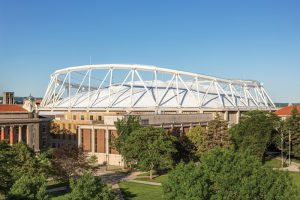The University of Syracuse Stadium (a.k.a. Carrier Dome) opened in 1980 and is covered by an air-supported PTFE coated fiberglass fabric roof. It was the first and remains the only domed stadium in New York State. The 50,000-seat stadium is prominently located on campus, home to Syracuse basketball, football, and lacrosse, while serving the larger community by hosting an array of events.
Although economical to construct, the stadium’s original air-supported roof had significant operating demands, including the need to maintain constant positive interior pressure to support the roof and a limited ability to support snow. In addition, any significant snow accumulation had to be melted or manually removed to prevent the roof from inverting. As the roof fabric was approaching the end of its design service life, the University chose to replace the roof with a new nonair-supported structure and tasked Geiger Engineers with the design.

In addition to the complexity of replacing an air-supported roof with a dissimilar structure, the University placed significant limits on the period that the facility could be closed. Syracuse Athletics heavily utilizes the stadium, requiring that the renovation allowed for facility use from September through February. In response, the new roof design was conceived such that the construction of the crown truss, which is the majority of the structure’s mass, is outside of the building envelope at the perimeter of the roof so its construction could proceed while the stadium remained in use. This required that the partially completed structure be engineered and the building verified safe for each event occupancy throughout the construction of the crown truss. The balance of the roof primary structure, a two-way cable truss, was developed to be rapidly erected following the closure of the facility and demolition of the air-supported roof.
The new roof is a creative solution addressing several other major challenges. First, it accomplishes the goal of passively resisting the very heavy snow loads of the region. The concept takes advantage of the skewed-symmetric layout of the original roof to achieve structural efficiency. More inspired, though, is how it repurposes the original compression ring as a key component of the new structure. Further, the unique nature of the design concept limited the new demands to be generally within the existing capacity of the supporting stadium structure. Optimization of the cable truss form and prestress capitalized on this concept in developing the design. The original structure required minimal modification to be incorporated into the new system. The benefit of this clever and resourceful design technique is partly evidenced by noting that the required reinforcement of the existing structure comprises less than 5% of the new work.
The crown truss upper ring is a primary component of the structure. Therefore, numerical optimization techniques were applied to determine the best geometry of the upper ring and cable truss form and prestress for a least-weight, efficient design while limiting the demands on the existing structure. The result is not just structurally efficient concerning materials and labor; it is also visually engaging and compliments the architecture of the existing stadium.
The crown truss bottom chord tension ring is laterally released at its supports on the stadium structure. It is located within the footprint of the original compression ring and rests on slide bearings, allowing the two to perform their respective duties independently of each other. The structural separation of these two major components in nearly the same space is a design feature that is visually inconspicuous yet enormously beneficial to the structural behavior of the combined system.
An innovation developed specifically for this project is the custom in-house software created to model the unique connections of the cable truss where certain cables cross and slide while remaining connected, a release condition not found in existing commercial software. This feature manifests in the use of compact bronze slide-saddles at these cable crossings, resulting in distinctive details throughout the structure that accommodate the expected displacements without engaging the cladding.
The new roof dramatically reduces the energy usage of the Stadium. It no longer requires 24/7/365 continuous fan operation to keep the roof inflated, does not necessitate snow melt, and has dramatically reduced the heat loss and gain compared to the old air-supported roof.
It is a testament to the construction team and the design that the new roof was completed on time without the need to delay or postpone any scheduled Dome events. The finished structure efficiently overcomes complex challenges and now passively supports snow without the need for monitoring or intervention. It is a creative, innovative, and iconic addition to the University campus and the Syracuse skyline that will be utilized for many years.■
